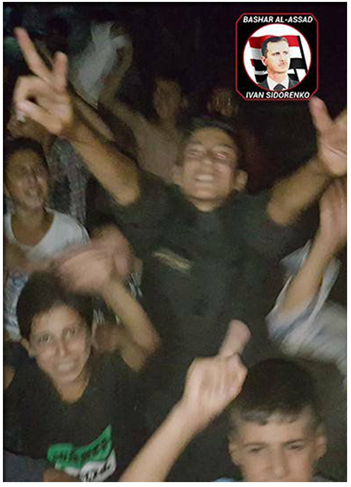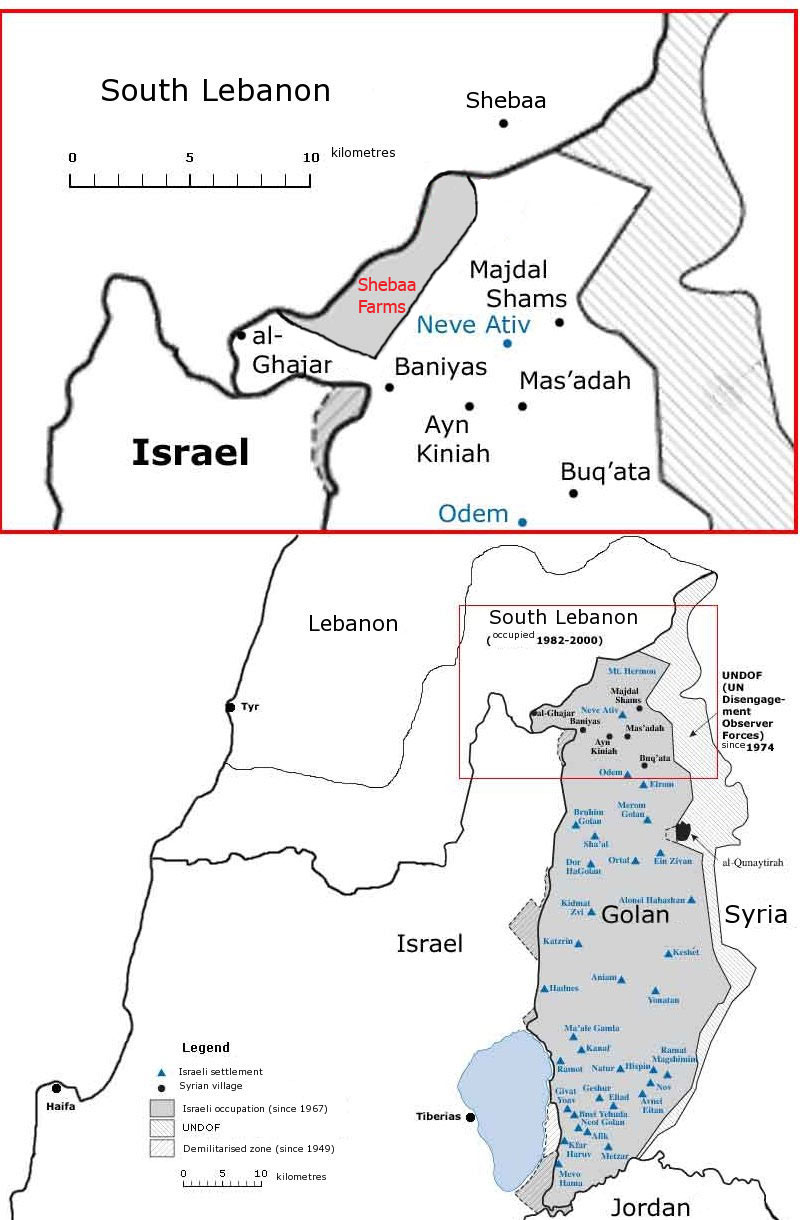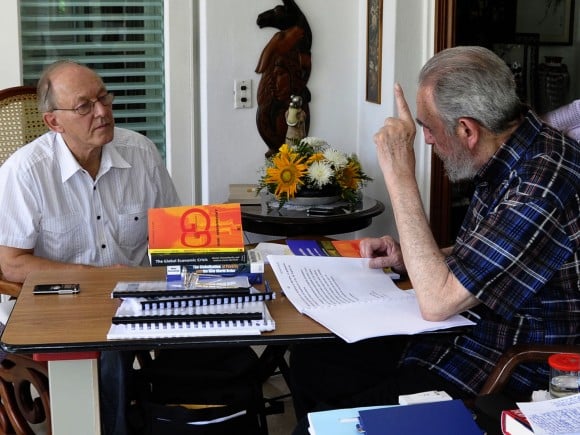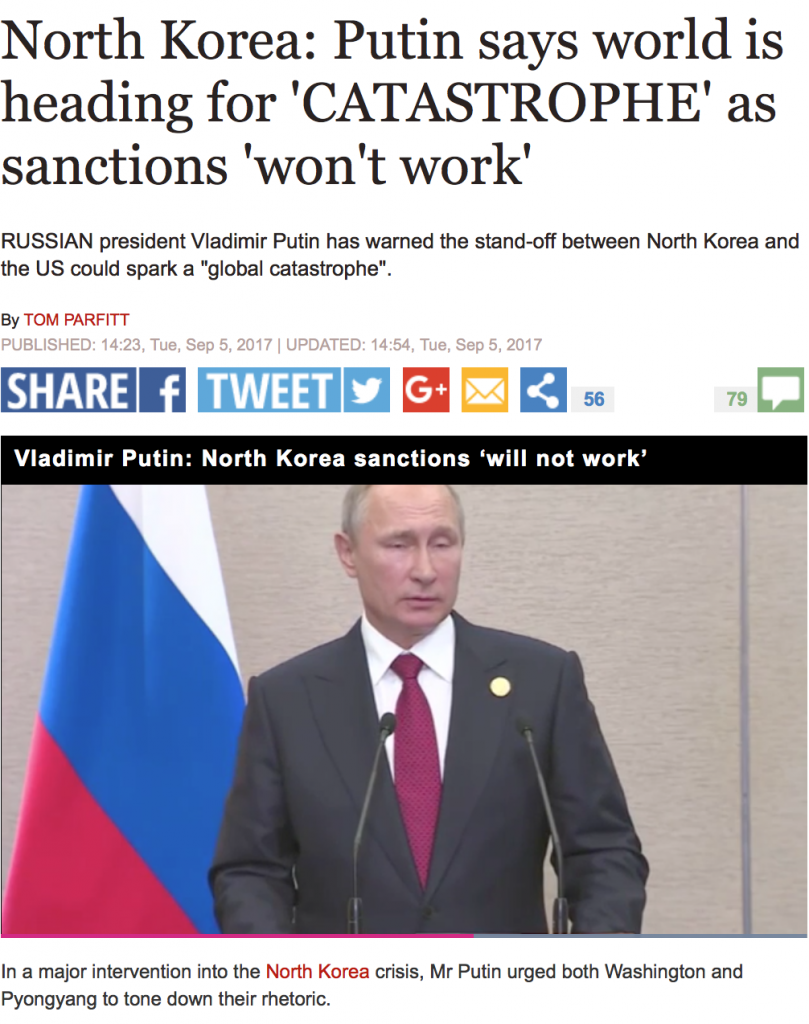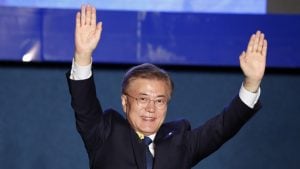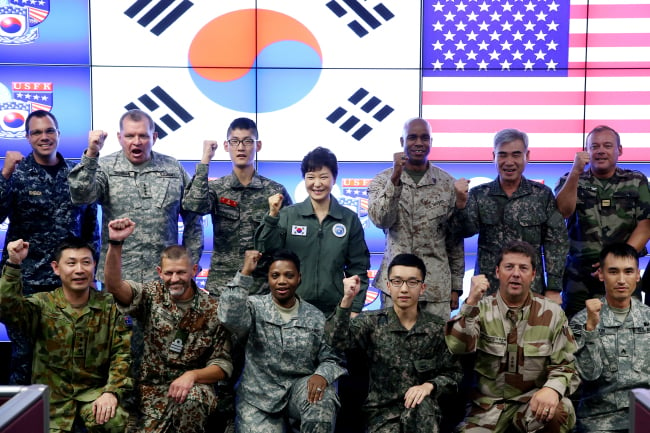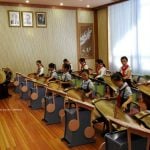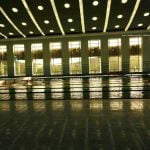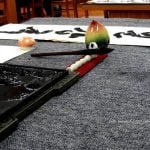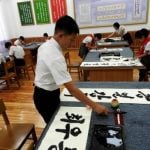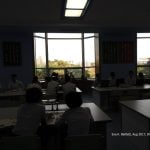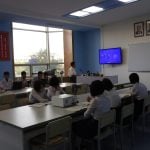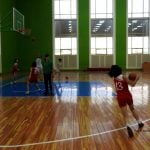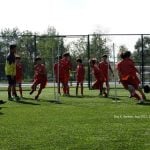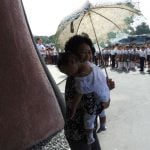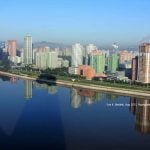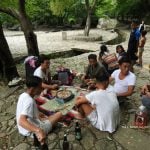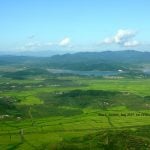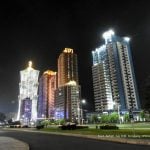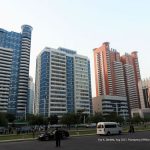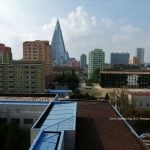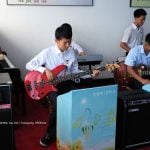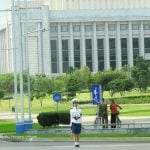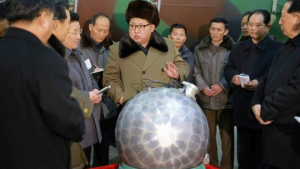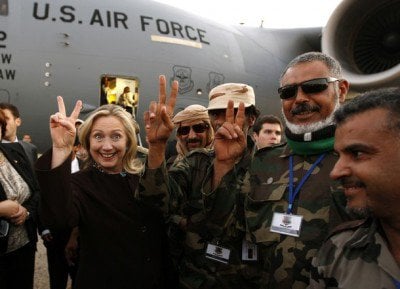The incredible growth of China’s cattle, sheep and dairy production is a visible phenomenon of the past twenty years, but its foundations were laid decades earlier. Seeking to industrialize its hinterland, and exploit its vast wealth of grazing livestock, China created slaughtering and processing facilities across its northern grasslands during the 1950s.
Since the 1980s, much of this infrastructure has been privatized by companies which, like their predecessors, seek efficiency through economies of scale. Brutal competition over price and constant arrival of new domestic and foreign players have encouraged the integration of processing chains, but also sidelined small operators, and created gaps in safety best epitomized by the 2008 tainted milk scandal. Despite steps taken to “green” the production chain, it remains to be seen if such gaps have been adequately filled.
China is among the world’s largest producers and consumers of beef, mutton and dairy. It is by far the world’s largest producer of sheep meat, with a 2013 output that was more than twenty times that of traditional exporters like Australia. China is also the second largest producer of beef, outperforming traditional producers like Argentina. From the 24th largest producer of milk in 1990, China has recently grown to the fourth largest, following only the EU, the US and India.1
The seeds of China’s cattle, sheep and dairy industries were planted over decades, but the visible results are fairly recent. As figure 1 shows, meat production of all sorts has expanded significantly since the 1980s. While pork has remained the quintessential meat, and its production has more than quadrupled, other meats have expanded at an even greater rate, increasing their share of China’s rapidly growing appetite for meat. Encouraged by development policy that prioritized the growth of ruminant meat production (summed up as “stable for swine, active for poultry and fast for cattle and sheep,”) as well as a seemingly insatiable domestic demand, beef, sheep and dairy industries all appear poised for significant further growth.2

Figure 1: Breakdown of Chinese meat production by four major types, 1980 and 20143
The significance of China’s cattle and sheep industries can be understood at least in part from their sheer size. China’s beef, mutton and dairy industries are massive—and they are growing. More than one billion RMB (147 million USD) worth of new beef and mutton contracts were signed at the 2014 industry trade fair in Baotou, and industry observers expect China to overtake the United States as the world’s largest consumer of dairy.4

Video introduction to the 2017 Baotou beef and mutton producers trade and industry fair. From fair website.
But beyond absolute market size, a new generation of Chinese enterprises is also changing and developing the industry as it integrates with global partners, and seeks efficiencies in mass production. Much of the industry today is inhabited by two different worlds, one of an abundance of small peasant household production and another of large concentrated modern farms. Although small household farms that raise less than 10 cows or 30 sheep have the largest proportion of farm ownership, their share of production is declining as intensification rapidly increases (see Tables 1 and 2).

Table 1: Number of Chinese Beef and Dairy Farms at Different Herd Sizes (2011/2014)5

Table 2: Number of Chinese Sheep Farms at Different Herd Sizes (2011/2014)6
The northern provinces of Inner Mongolia and Heilongjiang have been at the front line of these changes. While beef production has shifted to agricultural provinces like Shandong and Henan, Heilongjiang and Inner Mongolia remain dominant in dairy, and Inner Mongolia alone accounts for 22 percent of sheep production. Leading the way in the intensification of the industry (see Figure 2), new ventures in these northern provinces are being built on an eye-popping scale. Massive sheep farms in western Inner Mongolia aim to capture the Chinese market and envision replacing Australia as Asia’s export supplier of high-quality mutton. A Chinese-Russian joint venture being built near Mudanjiang will house 100,000 head of dairy cattle, more than three times the number at the largest dairy in the United States (and fifty times the 2000-head farms that some in Britain refer to as a “mega-dairy”).7

Figure 2: Percentage change between 2010 and 2014 for the number of Chinese beef farms with an annual inventory of over 1000 head8
The rise of large-scale sheep and cattle industries in China follows a worldwide trend in the growth of factory farming, and in China is both policy- and market-led. The party-state has sought to hasten industry development through a particular bias towards consolidation to large-scale farms as a means of promoting both quality (food safety) and quantity (food security) of meat and dairy production, and of addressing environmental concerns. Yet even as the number of household farms is decreasing, small farms (those with under 50 head) still produce the majority of livestock, and the increasing integration of production chains over long distances has in many cases created new roles for small farmers as specialist contractors. At the same time, consumer and regulatory responses to recent safety scandals have aimed to hold the large producers to greater accountability for quality, and for the overall “greening” of the industry. This complex and ongoing transformation of both production and consumption has commercial, ecological and dietary implications.
Timeline of government policies and industry growth
Trade in grazing animals has a long history in China. Centuries-old distance trade routes connected the grasslands of what is now Inner Mongolia to consumers within the Chinese provinces. Well into the twentieth century, there were lucrative annual drives of sheep into the northern cities, and a brisk trade in Chinese cattle to buyers in Hong Kong, Vladivostok, Osaka and beyond. But the origins of the present-day industry date back most tangibly to the 1950s, when projects associated with China’s first Five Year Plan (1953-1958) aimed to expand and develop animal industries across a strip of provinces from Xinjiang to Heilongjiang. A brief process of pastoral reform (muqu gaige), followed by willing or unwilling organization of newly sedentarized pastoralists into herding communes (muqu gongshe) gradually brought sheep and cattle into the command economy. Under the slogan of “building grassland industry,” iconic projects such as the Gannan Dairy in Lanzhou, and the country’s largest slaughterhouse in Hailar (completed in 1956 and 1957, respectively) supplemented the region’s existing wealth of herded animals with new industrial processing capacity. Although much of this product was destined for overseas markets, especially the Soviet Union and the Arab world, local consumption of meat and dairy in cities adjacent to herding regions remained high, even during periods of great privation such as the Great Leap Forward. At a national level, however, per capita consumption of both meat and dairy remained very low throughout the first three decades.9
The policies of the Deng Xiaoping era prioritized pastoral production for domestic consumption. The 1978 Household Responsibility System, best known for distributing collectively-held agrarian resources to farmers, also incentivized pastoral production by allocating animals and grazing access to herding households. The following year, the Ministry of Agriculture released the “Report on Accelerating the Development of Animal Husbandry Industry,” which aimed to industrialize meat production, and emphasized developing ruminant production.10 This new emphasis was voiced in 1980 when a visiting delegation of agrarian experts was told that China aimed to double per capita consumption of red meat and that most of this increase was expected to come from ruminant grassland animals, which consume less grain than pigs.11 This idea would later be enshrined in the 1992 Straw for Beef production subsidy, later re-named Straw for Ruminants.
While the reemergence of household pastoralism incentivized small producers, it also fragmented production. Increasingly during the 1980s and 90s, new policies emerged to promote consolidation and large-scale production. Subsidies, tax incentives and preferential land rental fees encouraged the transition to factory farms. In 1998, the “Decisions by the Central Committee of the CCP on Several Key Issues in Rural and Agricultural Work” designated companies that reached certain criteria of agricultural development—particularly through scale and vertical integration—as Dragon Head Enterprises (longtou qiye).12 Dairy received special attention, as a cheaper and more sustainable source of protein than meat. Dairy was heavily encouraged in the press (readers of the People’s Daily were repeatedly reminded that producing a kilogram of milk required one tenth the feed as an equal amount of pork) and in policies that established Dragon Head dairy enterprises in the Inner Mongolian cities of Hohhot and Zhalantun.13
By the beginning of the new century, meat and dairy production were poised for takeoff. In 2001, the State Council issued the “Opinion of Accelerating Livestock Development,” which advised for the stable development of pork and egg production, quickening the production of beef, mutton and poultry and emphasizing the development of dairy and fine wool production.14 New industrial capacity in meat packing allowed many producers to begin relocating further from urban markets, making production chains longer but more efficient. The shift was especially pronounced in dairy. Aided by the lower cost and increased capacity of milk powder processing, as well as the 1997 arrival of ultra-high temperature (UHT) processing technology, dairy producers began to concentrate production in new and ever larger facilities in Inner Mongolia and Heilongjiang. Industry growth was further precipitated by the 2005 Animal Husbandry Law which emphasized the importance of industrial modernization through the promotion of large-scale farms.
During this time, the increasing availability of feed changed the way that animals were raised, allowing much of the industry to depend less on pastures (including state grass farms) and more on farmed crops. China’s 2001 accession to the WTO introduced a flood of cheap Brazilian soybeans, which were pressed for oil, leaving the residue of pressed husks for animal feed. At the same time, the Heilongjiang corn belt was coming online as the nation’s supplier of feed grain. A 1988 article asking “when will China’s corn belt become its milk belt?” predicted this shift—the definitive answer came roughly a decade later when the southward flow of northern grain eclipsed in calorie terms the northward flow of rice for the first time in roughly a thousand years. Much of this new caloric wealth was Heilongjiang corn moving south for use as animal feed.15 More recently, cattle producers have begun importing high-quality alfalfa hay, largely from the United States. In January of this year, the Ministry of Agriculture issued the “National Alfalfa Industry Development Plan” (2016-2020), which aims to increase domestic alfalfa production, and build integrated hay and dairy farms. The use of more efficient feed, like grain crops or alfalfa hay, is one of the drivers of intensification for meat and dairy production in China.

Figure 3: Locations mentioned in text

Figure 4: Predominant land use classes

Figure 5: Population density
Figure 3 by authors, Figures 4 and 5 from here.
The global nature of livestock production, exemplified by the feedstuff trade, expanded in the early 1990s as foreign enterprises were allowed greater involvement in domestic production. In 1990, Nestlé established a joint venture partnership in Shuangcheng (near Harbin) with Shuangcheng Dairy and Food Industry. It accompanied a generational change in the Chinese industry, as iconic state ventures were one by one either shuttered or sold to new owners. The Hailar and Gannan dairies went to Chinese buyers, and the Hailar meat processing plant was purchased by investors from Singapore.16 These processes of internationalization, greater reliance on efficient feedstuff and policy support for vertical integration have spurred the intensification of the beef, sheep and dairy industries in China.
The intensification of sheep, beef and dairy production in the northern provinces was in part a recognition of the region’s natural advantages. With proximity to both grain and grassland, places like Hailar and Qiqihar had long been centers of animal trade, and towns like Anda in Heilongjiang had been producing and exporting milk products (often as butter) for well over a century. The intensification of production during the early decades of the PRC was centered on these provinces, but the limited ability to ship processed dairy (most often as milk powder) meant that most production remained near cities.17 As the market boomed in the 1990s, local governments in places like Baotou and Hohhot began courting these industries as a way of shoring up income as their worst polluting heavy industries were mothballed. Nationally, policy-makers continue to bias intensification with the “National Herbivores Animal Husbandry Development Plan (2016-2020)” through the explicit promotion of large-scale farms and the consolidation of the feed system in order to improve food safety standardization and to meet consumer demand.
Yet government support alone cannot explain everything. The government of Wuyuan County in Bayannuur offered financial incentives to its first generation of industrial sheep farmers, who nevertheless remained unable to produce at a profit. Unwilling to relinquish their subsidies, these ventures eventually resorted to renting sheep from local farmers in order to fool visiting government officials. In contrast, while many newer, successful ventures also enjoy good relations with government, and often preferential land and tax policies, they emphasize that the real attraction of a place lies in its productive advantages, which include the iconic value that certain locations have for consumers, who associate beef, mutton and milk with the romantic image of the grasslands. As one manager described it, “Inner Mongolia is its own brand.”
New business models
The most visible change to the industry has been in quantity—the number of producers, and emergence of super-sized enterprises like the sheep producer Green Grassland (Qingqing caoyuan), or the dairy giants Mengniu and Yili—but just as important is the increasing integration of supply chains at every stage of the production process. Eased by cheap transportation costs, longer production chains have also grown more complex. Seen from any one vantage point, this change might be mistaken for a single shift from one “model” to another, for example abandoning pure pastoralism in favor of higher density stock breeding. But like agriculture, animal industries are grounded in local realities, and their business factors change from year to year. A practice or relationship that has been discovered to work in one place may not work in another, and one that is economical at one time might not be so the next year. The result is that even the largest enterprises do not have a single production chain, so much as a production network, with each node presenting choices and opportunities to change practices, mix and match new suppliers, and outsource or insource individual stages of production.
Consider the pastoral production of the mid-twentieth century. In places like Inner Mongolia or Qinghai, where herded animals were abundant, the value of the live animals was relatively low. Rather, the value was in the processed product—wool, hides or meat—and specifically, the ability to get that product to market.18 The cost of construction of industrial animal processing, such as slaughtering, chilling and shipping facilities was often the difference between development and stagnation. It is largely what separated the quick regional development of Hulunbuir, which was crossed in 1903 by a railway and subsequently enjoyed a succession of Russian, Japanese and Chinese infrastructural investment, and the lagging development of neighboring Xilingol, which did not.19
Large processing complexes such as the sprawling Hailar slaughterhouse became the economic center of entire pastoral regions, and the bottleneck in a linear production chain: until the 1980s, herds of cattle and sheep were driven by nine-man teams into Hailar from as far away as 150km, a process that was both exhausting, and expensive because the animals lost significant weight along the journey. While the reforms of the 1980s have shifted the task of conveyance to professional middlemen, who purchase and deliver livestock by truck, the basic mechanism remained the same because choices for slaughtering, and thus for sale, were highly limited.
Changes since the 1990s have introduced an increasing number of choices at all stages of production. One of these choices is in how the animals are raised, meaning that a great deal of primary production now falls somewhere in between pastoralism and farming. The overall lower cost and increasing availability of grass (either imported from abroad or trucked in from grass farms in places like Jilin) and of different commercial feeds allows farmers to mix different feed styles, for example following one season of grazing with another of farm feeding, or supplementing a grass diet with feed during periods of heavy milking, or before slaughter. Again, many of these decisions will change year to year, depending on the constantly shifting mix in price factors.20
Mega-farms like Green Grassland are the most visible manifestation of this new value chain. Founded in 2014, Green Grassland has 100,000 sheep at its main facility in Wuyuan, and smaller numbers at production sites in Henan and Xinjiang. It also maintains its own facilities for feed production, slaughtering, processing and distribution. People at Green Grassland were universal in their conviction that pure pastoralism has no future in China. While pastoral production is in some ways less expensive, it is also unpredictable, subject to season and weather, and produces a non-standard product that the market no longer wants. By integrating the entire production chain, Green Grassland aims to out-compete pastoral production on quality assurance. With the efficiencies of large scale operations, they now expect to outcompete on price as well.

Green Grass proprietary feed

Feed plant under construction
But even this integrated chain is not an island. Green Grassland does not breed its own lambs: for that it depends on outside breeders in places like Tongliao, 1,400 km to the northeast, where it keeps an on-site facility and buying agent. Last year Green Grassland bought over 100,000 lambs from these small producers, who have grass and feed in abundance, but no market for their adult animals. Besides outsourcing breeding, Green Grassland also commissions local factories to produce some of its feed (a second feed factory is expected to come online in 2018), and rents out use of its slaughtering and packing facilities to other producers. Even a very highly integrated production chain like Green Grassland depends on the outside for services and supplementary income.

Lambs recently arrived from Tongliao to Green Grass farm
A different transformation is taking place within dairy. Like the trade in meat animals, an earlier model of production connected dairy farmers in a linear hierarchy to milking or collection centers (shougoudian) in the village or county. Villages that were designated as milk “bases” were encouraged to specialize in milk production, and perhaps more frequently checked for sanitary conditions, but otherwise remained left largely to their own devices, and like the rest of the industry, constrained by the artificially low price paid for milk.21 Throughout the explosive growth of the 1990s, this segmented model remained the standard—even mega-producers like Mengniu and Yili bought most of their milk from privately operated milking stations. The milk itself came from millions of small producers, each with only a few dairy cows, and often run by former farmers who were new to the industry. After the Fuyang milk crisis of 2003, in which nutrient-stripped milk powder was sold by illegal operators, government action further prompted consolidation of production around a few key players who, it was hoped would have sufficient incentive to police quality control.
The 2008 melamine crisis revealed in spectacular fashion the weakness of this policy. Later investigations implicated every stage—production, collection and purchasing—of milk production to have been susceptible to quality tampering. The subsequent move to scale, outlined in the State Council document 122 “Outline of Program to Consolidate and Develop Dairy Industries” was implemented precisely in order to tighten the integration of production chains.22 Higher-end producers either rely on dedicated suppliers or increasingly produce their own milk on site. The Nestlé complex in Erguna buys exclusively from a number of dedicated suppliers in a 150km radius. The former “dairy base” township of Hake near Hailar is now home to one of these suppliers, which is not only routinely inspected for the health of its animals and sanitation of its facilities but is also required to use milking machinery and feed supplied directly by Nestlé. The result is a higher cost of operations, but also a much higher sale price for their product. The company was very proud of their arrangement with Nestlé and very keen to preserve it. Other companies have variations on this theme: Qingdao-based United Dairy operates industrial dairy plants in Heilongjiang and Inner Mongolia, but leases milk cows from local farmers, thus maintaining quality control while avoiding large upfront costs.23
Conversely, the diversity of production systems does leave options, albeit more limited ones, for those who operate outside of these more demanding chains. Cattle and sheep producers in Hulunbuir still sell to the larger and smaller slaughterhouses in Hailar, but many of these are lower tech operations that cater primarily to local restaurants and wet markets: cattle and sheep are delivered and slaughtered before sunrise, and the meat is shipped and sold within a day, all without any further processing. Like the sheep farmers in Tongliao, many large and small cattle farmers in Hulunbuir sell their newly weaned calves to professional buyers, keeping only a portion of the breeding adults.

Milk and yoghurt vendor in Xining


Scenes from wet market slaughterhouse in Hailar
The difference between these tracks of production is more stark in dairy. In the early 1990s, there were dozens of dairy brands, most of which distributed on a provincial or smaller scale. By 2010, the three largest producers together controlled about 40% of the national market (Mengniu and Yili each enjoy about 16%, Guangming another 8%), with the remainder divided among another 700 smaller producers. By 2012, the share of the top three had reached 60%.24 Most cities have some dairy production nearby, often smaller enterprises with one or two thousand head of dairy cattle. Many of these smaller farms have in reality been wholly or partially bought out by the large producers, who hope to use the name recognition of numerous brand streams. But others remain more independent and survive by focusing on a niche product such as milk powder or dried yoghurt. Others such as such as Great Wall Dairy near Zhangjiakou, or Clear River, Green Pasture Dairy near Hailar operate exclusively in the less technologically demanding end of the local market, producing chilled fresh milk and yoghurt, but not intending to move into more distant markets.
The smallest farmers are often the most adversely affected by these consolidation processes. Those who sell to milking stations generally have no bargaining power on price, while the direct market is fast disappearing—the sight of individual farmers selling milk or yoghurt on street corners is becoming rare even in small towns. Those who do go this route often receive very little for their product, and can only continue to operate because their own production costs are extremely low, but even these may soon be undercut by the national distribution of UHT packed dairy from the major processors.
Ecology
The ecological impact of animal production can manifest in different ways, over the short and longer term. The expansion of primary production in the 1950s, exemplified by significant herd growth in places like Hulunbuir, was made possible in part by the digging of wells, which provided watering stations, but also lowered the water table, thus creating significant problems that were felt years down the road.25 The larger herds also became a problem, not just because of their size, but also because command purchasing encouraged communes to abandon cows in favor of sheep, which breed more quickly, but are more damaging to grass cover (see Figure 3. The early 1980s recovery of cattle herds was in significant part due to the new boom in dairy production.)

Figure 3: Cows as proportion of herd size in Hulunbuir, 1949-1989.26
Under the Household Responsibility System, herders were again allowed to own individual animals, but grazing land remained public, and thus subject to the tragedy of the commons. The more recent policy of allocating blocks of pastureland to individual families was intended to encourage users to take the lead in preserving pastoral resources, but in many cases has done the opposite by clustering animals around fixed facilities like pens and feeding stations, and by preventing the earlier practice of alternating summer and winter grazing grounds.27
Policy concern for rangeland conservation can be traced back to the reform period due to the obvious effects pastoral activity has had on grassland ecology (many estimates claims that “more than 90 percent [of remaining natural grasslands] are degraded”).28 The 1985 Chinese Rangeland Law combined goals of ecological improvement and economic development in the pastoral region, with the advancement of a modern animal husbandry industry. Specifically, this law advocates the establishment of large-scale, intensive farms in the interest of advancing pastoral conservation. Intensive farms are seen as a way to efficiently meet growing consumer demand by shifting from forage to feed and external hay production. Aware of intense degradation of grassland, the Ministry of Agriculture issued the 1988 “Implementation Measures for Carrying out the State Council Decision on the Key Points of Current Economic Policies” in order to shift cattle and sheep production to agricultural provinces like Henan and Shandong.29 Additional policies such as the 2000 “Returning Grazing to Grasslands,” the 2003 Grazing Ban Program and the 2011 “Rangeland Ecological Compensation Program” were all designed to restrict overgrazing, and incentivize grassland restoration. The Chinese government reported 7,569,900 hectares of newly increased grasslands in the year 2014 alone.30
In the same way, the move from grazing to feed farming is not a single ecological phenomenon—it represents both threats and opportunities. One important benefit is that the production of feed crops generally takes place in areas that are more ecologically stable compared to grassland, much of which is dangerously prone to desertification if overgrazed. Besides corn, which is grown on rich but sparsely populated regions of the far north, much of the feed is derived from secondary products, such as the husks leftover from oil-pressed soybeans, or chu, a mixture of green matter (generally corn stalks) that has been crushed into mash and fermented. Investment in processed feed production, and the increasing availability of imported feed like alfalfa hay, have largely eased the price crises of the mid-2000s.31 That does not mean that they are without cost. The extensive use of land and water resources for producing feedstuffs strains China’s already limited resources for human food production, and imports merely shift the environmental consequences of meat and dairy production onto others, most notably the expansion of Brazilian soybean production on reclaimed land from the Amazonian rainforest, an essential part of our Earth’s lungs.



Erosion-prone landscapes in Chifeng and Tongliao. These areas are closed to grazing, and neighboring ones have been newly planted in trees.
The question of waste is similarly complex. Collected animal waste becomes a problem when it is unable to break down naturally and is instead allowed to run into groundwater and streams. Facilities such as the massive dairy near Mudanjiang (and a slightly smaller one near Heihe) have been accused of negligent disposal, allowing waste from tens of thousands of cows to run into the Amur River, and from there out to the open sea. But at least some new enterprises are building such concerns into their production chain. Green Grassland plans to manufacture its sheep droppings into a fertilizer that is specially formulated to the region’s salty soils. Industry action is reflected in new policy documents specifically targeting the utilization of waste, as seen in the 2014 “Regulation on the Prevention and Control of Pollution from Large-scale Breeding of Livestock and Poultry.”
Policies limiting grassland use also feed directly into China’s afforestation plans, an ambitious and strenuously pursued campaign that began in 1978 and eventually aims to plant 90 million acres over the coming decades. From this perspective, feed farming frees up pasture for natural recovery, and in some cases for tree planting. Although these greening efforts are not without controversy, the large meat and dairy concerns have embraced them as willing partners and good corporate citizens. According to an Yili press release, timed for the same day as an important central government statement on environmental protection, the company spent 150 million RMB (24 billion USD) on various conservation projects in 2016 alone.32
Food safety and the Chinese diet
Rising consumption of animal protein—of which beef, mutton and dairy are (from a national perspective) a small but growing proportion—has transformed the Chinese diet. Increasing consumption of dairy, in particular, has been a longstanding priority of generations of nutritionists, agrarian specialists, and the Chinese party-state as a whole. Contrary to popular belief, the custom of consuming dairy was by no means a Western import—as far back as the late Qing, parts of the Northeast were producing, consuming and exporting dairy products, while other regions processed different varieties of fermented or dried cow and water buffalo milk into products that became known local specialties (processing preserves fresh milk, and also denatures the proteins that cause digestive difficulty).33

Figure 4: Breakdown of Chinese meat consumption by four major types, 1991 and 201534
Milk had a special place in the cultural life of the early People’s Republic. During the 1950s, milk became a symbol of the socialist good life, and amity with the Soviet Union. Decades before the current increase in production made milk products a feature of daily life, state publications like People’s Daily were promoting the health benefits of dairy consumption, especially for children and the elderly. The “milk crisis” of the early 1980s, a shortage of dairy that had Beijing consumers lining up at three in the morning, was one of the first tests of urban confidence in the decade’s reforms.35 Since the 1980s, dairy companies have been publicly promoted as examples of well-run enterprises, and as responsible corporate citizens. Yili was a sponsor and the official dairy supplier of the 2008 Beijing Olympics, and following earthquakes in Wenchuan and Ya’an, Mengniu and Yili each donated thousands of cases of milk and milk powder to the disaster victims.36 In 2000, seven central government departments collaborated on a nationwide campaign to encourage students to drink milk for better nutrition. In 2006 Premier Wen Jiabao famously added as hispersonal dream the wish that each child in China would be able to drink one jin (half a liter) of milk per day.37
There has been less focused national support for cattle and sheep production, nor the same kind of visible promotion of meat industries. Where such support exists, it is often from provincial or local level governments who seek the revenue derived from a large producer setting up operations. Even without promotion, domestic demand has grown so quickly that almost none of China’s vastly expanded production of beef and mutton goes to export—at best Chinese production slows the tide of imports from Brazil, Australia and, as of July of this year, the United States.
From the consumer perspective, beef, mutton and dairy products are all highly, and increasingly desirable. Some of this new market represents generational change: while older consumers might once have balked at the strong taste of mutton, or considered beef too troublesome to prepare at home, the arrival of higher quality and pre-prepared meat (such as processed meals or beef jerky) and fast foods such as beef noodles, and of course McDonald’s and its imitators, have made these meats familiar items of daily consumption. In urban supermarkets, pallets of UHT packaged yoghurt milk are a common sight. Yoghurt and various other dairy products—fresh milk, milk powder, milk tea and milk candy—will frequently take up 15% or more of floor and shelf space.


Yoghurt and milk candy on store shelves
The rapid growth of meat and dairy consumption takes place in the context of very high public concerns over food safety, epitomized by frequent stories of meat of questionable provenance (including horrific reports of buns stuffed with dirty cardboard, or rat meat disguised as lamb) making its way into meat filling or the roasted meat sold in street markets. Dairy is especially prone to problems. Chinese state newspapers were reporting on milk adulteration as early as 1980. In 1987, People’s Daily reported that virtually all milk produced in Heilongjiang was adulterated with water, much of which was itself unsafe for drinking.38
The iconic case, and perhaps the tipping point in the industry was the 2008 melamine poisoning scandal. The addition of this toxic industrial chemical to milk artificially boosts protein readings, and its widespread use throughout the industry was responsible for sickening nearly three hundred thousand consumers, of whom at least six infants died of renal failure. The scandal was immediately laid at the feet of Hebei-based Sanlu dairy, but the problem was, in fact, endemic throughout an industry that had become obsessed with cutting costs at every turn. The two largest producers were accused of routinely buying substandard-quality milk from collection stations, which in turn drove down prices paid to small producers, at the very moment that feed had jumped in price.39 Even if sales of the most affected products have since recovered, and now continue more or less unabated, production scandals have left an indelible mark on consumers—witness the daily sight of Chinese tourists in Hong Kong MTR stations filling up suitcases with cans of “safe” milk powder to sell in Shenzhen.
More than anything that came before it, the 2008 scandal was felt across the entire food industry. Executives from Sanlu were harshly sentenced (including some being given the death penalty), and perhaps more to the point, the collapse of market confidence and costs of recalling more than ten thousand tons of tainted milk powder drove the company to bankruptcy. In December of 2008, its assets were sold off at 40% of their original value, while New Zealand’s Fonterra, which had bought a 152 million USD stake in the company, lost its investment entirely. Companies that were not as directly implicated in the scandal fared only slightly better. Mengniu and Yili each lost 80% of their sales in the first ten days, and together suffered direct losses estimated at half a billion dollars. Combined with a second melamine scandal in manufactured pet food, the image of Chinese food safety took a pummeling. Entirely unrelated food exports (such as shellfish) out of Qingdao and Guangzhou all suffered visible losses.40
One clear effect of the crisis has been strong push to consolidation around megafarms. This is particularly clear in dairy, which was already consolidating around large processors before 2008, and has since called for scale in primary production as well. The “Outline of Program to Consolidate and Develop Dairy Industries,” released in the aftermath calls for increased state support for large scale enterprises, and set growth targets for the number of farms with more than one hundred dairy cows.41 Other government policies since the scandal have continued to push this aim of concentrating and consolidating production in the meat and dairy industry.
Other effects remain difficult to assess. Driven on by the wave of consumer outrage, the Chinese government acted quickly to enact the 2009 Food Safety Law, as well as a series of reforms aimed at assisting small farmers who had been squeezed in the price war between the largest producers. Although new safety standards now demand inspection of all food producing facilities, it remains to be seen how the maze of responsible government departments could possibly police a sprawling production base of “millions of small dairy farmers, tens of thousands of milk collection stations and hundreds of milk processors, large and small,” especially since, as one study suggests, economies of scale remain financially incentivized to aim for quantity over quality.42 Clearly, the corporate world is betting on the recovery of the large producers. The pace of acquisitions and cross investment quickly recovered in the years following the scandal, with major names like the French multinational Danone significantly increasing their stake in China’s major players.43
In any case, meat and milk producers now sell safety as their key advertising line. Pastoral and farm-based meat producers each market a different angle: grassland beef and mutton advertise their product as organic and natural, while farm producers such as Green Grassland sell as its primary asset the safety of its internally integrated production chain. At the Baotou beef and mutton industry conference, such concern with food safety was on constant display, with nearly every vendor touting a green production line. The ability to market freshness and safety is especially compelling for milk producers, for whom reputation is integral to brand success. Beyond the obvious step of marketing images of happy cows in green fields, dairy producers have begun encouraging public visits to their facilities. Clear River, Green Pasture Dairy in Hailar, which promotes the safety and freshness of its product, recently had one such event. The websites of large producers such as Yili even promote tours for school children.


A selection of “green meat” ads.
Conclusions
It feels premature to present conclusions for a process that is unfolding and indeed accelerating before our eyes. Yet a few points deserve to be brought to prominence. The first is that by many measures, China’s cattle and sheep industries do appear to be laid on a firm foundation, and poised for significant further growth. Consumer demand continues to grow, even in the face of safety scandals, and the integration of foreign chains introduces a wide variety of opportunities for Chinese producers, from the direct export of Chinese food to the processing of foreign products in Chinese facilities. Ecological considerations are complex and beyond easy characterization. At best, they are a series of tradeoffs: attempts to reverse grassland degradation come at the cost of exporting these problems to other producers, while the efficiencies of large scale production create their own problems of waste disposal, animal welfare and accountability.
Secondly, although the shift to large scale farming is clearly a government priority, the effect of scaled-up production, and influence of foreign and Chinese corporate players is far from clear. The food adulteration scandals of the 1980s and 1990s derived in part from the inability to police, or even trace the thousands of new small producers that had emerged in the early Reform Era. Many had assumed, or at least hoped that increasing foreign investment and the winnowing of the field to a few key players would produce a competition for quality, or at least concentrate accountability for breaches in food safety. The 2008 melamine scandal, which was disproportionately concentrated among the country’s largest dairy producers, proved the opposite—that no holds barred competition for price can just as well produce a race to cut corners. Although the market for milk products has improved, it is still early to predict the long-term effect of the scandal, or of the new food safety laws on production practices, or the appetite of investors or consumers for Chinese products.
Note: In addition to cited sources, this article draws on interviews conducted by DuBois in 2016 and 2017, in and around most of the locations discussed in this article. Unless noted, images are from this fieldwork. Further examination of the historical content is currently under review for separate publication.
Notes
1 Production statistics from FAO.
2 “稳定发展生猪和禽蛋生产,加快发展肉牛、肉羊和肉禽生产,突出发展奶牛和优质细毛羊生产” Guanghong Zhou, Wangang Zhang and Xinglian Xu.“China’s Meat Industry Revolution: Challenges and Opportunities for the Future.” Meat Science (2012) 92: 188-196, 189.
3 FAO.
4 Baotou; counting both contracts and agreements, Baotou news cites a figure five times as high here. See here.
5 China Animal Husbandry Industry Yearbook. Beijing: China Agriculture Press (2012). China Animal Husbandry and Veterinary Yearbook. Beijing: China Agriculture Press (2015).
6 China Animal Husbandry Industry Yearbook. Beijing: China Agriculture Press (2012). China Animal Husbandry and Veterinary Yearbook. Beijing: China Agriculture Press (2015).
7 See here, here, here and here.
8 China Animal Husbandry Industry Yearbook. Beijing: China Agriculture Press (2011). China Animal Husbandry and Veterinary Yearbook. Beijing: China Agriculture Press (2015).
9 See here, Renmin ribao (RMRB) 56/7/4, 57/9/26
10 Peter J. Li. “Exponential Growth, Animal Welfare, Environmental and Food Safety Impact: The Case of China’s Livestock Production.” Journal of Agricultural and Environmental Ethics (2009) 22:217-240. 230.
11 Jacob A. Hoefer and Patricia Jones Tsuchitani, Animal Agriculture in China: A Report of the Visit of the CSCPRC Animal Sciences Delegation. Washington D.C.: National Academy Press (1980), 69
12 Qian Forrest Zhang and John Andrew Donaldson. “The Rise of Agrarian Capitalism with Chinese Characteristics: Agricultural Modernization, Agribusiness and Collective Land Rights.” The China Journal(2008) 60: 25-47. 29.
13 RMRB, 88/7/12, 95/2/10, 99/5/29
14 China Animal Husbandry Industry Yearbook. Beijing: China Agriculture Press (2002):87. This document was first drafted by the Ministry of Agriculture in 1999.
15 RMRB, 88/9/8; Zheng Yougui, et al., “The South-to-North and North-to-South Flows of Grains and Cereals—Changes to Directions and Quantities of Flows of Grains and Cereals between North and South in Contemporary China,” in Thomas DuBois and Huaiyin Li, eds. Agricultural Reform and Rural Transformation in China since 1949 (Brill 2016): 267-286.
16 RMRB 97/2/14
17 RMRB 54/1/29
18 Something similar was seen in early twentieth century Argentina, leading to fairly brutal competition between British and American firms over the processing bottleneck in Buenos Aires.
19 Early twentieth century buyers for the Harbin slaughterhouses concentrated on Hulunbuir, and would only venture to Xilingol when unusually high sale prices warranted the extra cost of transportation to Hailar. After 1980, these costs were often passed onto the seller. China Eastern Railway (CER), North Manchuria and the Chinese Eastern Railway, Harbin, China: CER Printing Office, 1924, 135-150. Xilingol transporation costs are mentioned in Wang Xiaoqiang and Bai Nanfeng, The poverty of plenty. Basingstoke, Hampshire: Macmillan, 1991.
20 Surveys of small dairies in 1930s shows a similar mix of feed strategies.
21 Zhongguo naiye 50 nian (Beijing: Haiyang chubanshe, 2000) 3; China, the livestock sector. Washington, D.C.: World Bank, 1987 (unpaginated).
22 Changbai Xiu, K.K. Klein, “Melamine in milk products in China: Examining the factors that led to deliberate use of the contaminant? Food Policy 35 (2010) 463–470. Li Chengguo, et al. eds., Zhongguo naiye shi [History of Chinese dairy] (Beijing: Zhongguo nongye, 2013) 314-321.
23 Jingjing Wang, Mei Chen, Peter G. Klein. “China’s Dairy United: A New Model for Milk Production” American Journal of Agricultural Economics (2015) 97 (2): 618-627.
24 Zhongguo naiye shi, 282. Changbai Xiu, K.K. Klein, “Melamine in milk products in China: Examining the factors that led to deliberate use of the contaminant? Food Policy 35 (2010) 463–470. Shefali Sharma and Zhang Rou. “China’s dairy dilemma: the evolution and future trends of China’s dairy industry.” Washington: Institute for Agriculture and Trade Policy (IATP). (2014): 9.
25 See here.
26 Hulunbeier meng zhi, 810-811
27 James R. Simpson and Ou Li. “Feasibility Analysis for Development of Northern China’s Beef Industry and Grazing Lands.” Journal of Range Management (1996) 49(6): 560-564. The wide diversity of pastoral systems, and the relative ecological impact of different sorts of production are outlined in detail in Caroline Humphrey, and David Sneath. 1999. The end of nomadism? society, state, and the environment in Inner Asia. Durham: Duke University Press.
28 Scott Waldron, Colin Brown and John Longworth. “Grassland Degradation and Livelihoods in China’s Western Pastoral Region: A Framework for Understanding and Refining China’s Recent Policy Responses” China Agricultural Economic Review 2(3). 2010. 298-320. It should be noted that this statistic has been criticized as being over generalized and based on meager evidence. See Emily T. Yeh. “Green Governmentality and Pastoralism in Western China: ‘Converting Pastures to Grasslands.’” Nomadic Peoples (2005) 9 (1-2): 9-30. Over-grazing was one of the top official reasons given for grassland degradation by the Ministry of Agriculture. Limin Hua and Victor R. Squires. “Managing China’s Pastoral Lands: Current Problems and Future Prospects.” (2015) 43: 129-137.
29 Li 2009, 232.
30 National Bureau of Statistics. China Statistical Yearbook, Beijing: China Statistics Publishing House (2016).
31 A People’s Daily article called for the industrial production of fermented green fertilizer as early as 1960: RMRB 60/3/5. Zhongguo naiye shi [History of Chinese dairy] (Beijing: Zhongguo nongye, 2013) 294. More recent programs to expand feed production are discussed here and here.
32 See here.
33 Mak Sau Wa. 2012. Milk and Modernity: Health and Culinary Heritage in South China, PhD thesis, Anthropology, Chinese University of Hong Kong.
34 OECD-FAO Agricultural Data.
35 RMRB 81/8/24.
36 See here, RMRB 13/4/22.
37 See here.
38 RMRB 80/3/28, 83/7/11, 84/2/17, 87/7/17.
39 Changbai Xiu, K.K. Klein, “Melamine in milk products in China: Examining the factors that led to deliberate use of the contaminant? Food Policy 35 (2010) 463–470
40 Ruijia Yang, Wei Huang, Lishi Zhang, Miles Thomas & Xiaofang Pei, “Milk adulteration with melamine in China: crisis and response” Quality Assurance and Safety of Crops & Foods, 1, 2 (2009): 111-116. Changbai Xiu, K.K. Klein, “Melamine in milk products in China: Examining the factors that led to deliberate use of the contaminant? Food Policy 35 (2010) 463–470.
41 Zhongguo naiye shi [History of Chinese dairy] (Beijing: Zhongguo nongye, 2013) 290-291.
42 Zhen Zhong, Shufen Chen, Xiangzhi Kong, Megan Tracy, Why improving agrifood quality is difficult in China: Evidence from dairy industry, China Economic Review 31 (2014) 74–83. Changbai Xiu, K.K. Klein, “Melamine in milk products in China: Examining the factors that led to deliberate use of the contaminant? Food Policy 35 (2010) 463–470.
